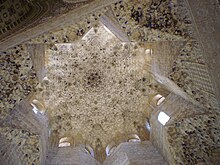Muqarnas

As muqarnas ( Arabic مقرنص, DMG muqarnaṣ , also Mukarnas ; Persian مقرنس, DMG moqarnas ) or stalactite or Stalaktitengesims is a style element of Islamic architecture called. It is usually used as the top closure of niches or in the gussets at the transition between a square base and a dome .
Muqarnas usually consists of a large number of pointed arch-like elements that are placed inside and on top of each other in order to create a transition between the niche and the wall or between the walls and the dome. Complex, artistically designed muqarnas are almost reminiscent of stalactite caves and are therefore also referred to as stalactite decorations .
It emerged as an architectural element of Persian architecture in the middle of the 10th century and quickly spread throughout the Islamic dominion from Spain to Central Asia , occasionally even to Indonesia . The oldest muqarnas in the Persian region come from the area of Nishapur and from the Arab-Ata mausoleum near Tim ( Samarqand province , Uzbekistan). Numerous examples are known from the Seljuk period. The oldest muqarnas in Iraq can be found in the Imam ad-Dawr mausoleum (in the village of ad-Dawr, 20 kilometers north of Samarra ), built between 1075 and 1090. In North Africa, typical muqarnas can be found from the 12th century.
In Ottoman architecture , stalactites can also be found on the sherefes (balconies) of the minarets .
literature
- Yasser Tabbaa: The Muqarnas Dome: Its Origin and Meaning. In: Muqarnas. 3, 1985, ISSN 0732-2992 , pp. 61-74, doi : 10.2307 / 1523084 .
Web links
- Bernhard Peter: Muqarnas and stalactite vaults. Kultur-in-asien.de (examples of muqarnas in Uzbekistan )

